We occasionally link to goods offered by vendors to help the reader find relevant products. Some of these may be affiliate based, meaning we earn small commissions (at no additional cost to you) if items are purchased. Here is more about what we do.
I’m throwing this question out there to the world: how badly do you struggle with buying the right type of coconut milk at the store?

What are you supposed to choose? Milk or cream? Does it matter if it’s packaged in a carton or can?
And cream of coconut couldn’t possibly mean anything other than a can of coconut cream!
Wait… right?
What is this madness?
It’s easy to be steered towards certain options with super low price points or pretty labels, or simply going on gut instinct, when you’re feeling overwhelmed by the choices at the grocery store. But here is your opportunity to take control of your next shopping trip, and get exactly what you need.
With this article, you’ll really learn the differences between these two versatile dairy-free ingredients, as well as everything else in between!
What’s the Difference Between Coconut Milk and Coconut Cream?
The Anatomy of a Coconut: The Source
While there is a heated debate as to what came first between the chicken or the egg, there is no doubt that the coconut is the source of all its food byproducts!
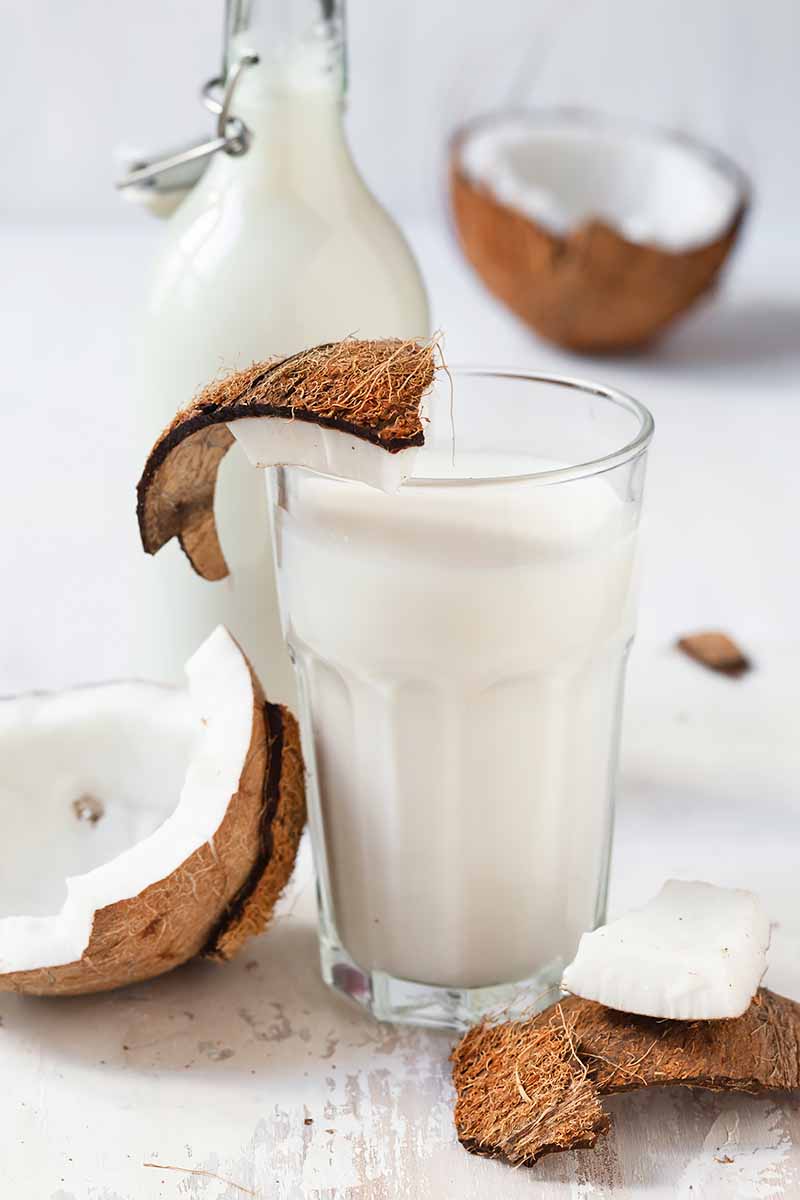
A single-seeded drupe, it is the fruit of Cocos nucifera, the coconut palm.
The ripe fruit’s anatomy has a few key components: the husk, the shell, and the endosperm.
The husk makes up the inedible exterior layer. This thick and fibrous portion of the fruit surrounds and protects the seed, which is composed of the endocarp and endosperm.
The endocarp is the thin shell that surrounds the inner endosperm.
The endosperm, composed of both solid endosperm (coconut meat) and liquid endosperm (coconut water) is what feeds the drupe as it matures, providing a condensed source of nutrients and moisture for its growth and development.
The maturity of the fruits determines the interior structure of each one.
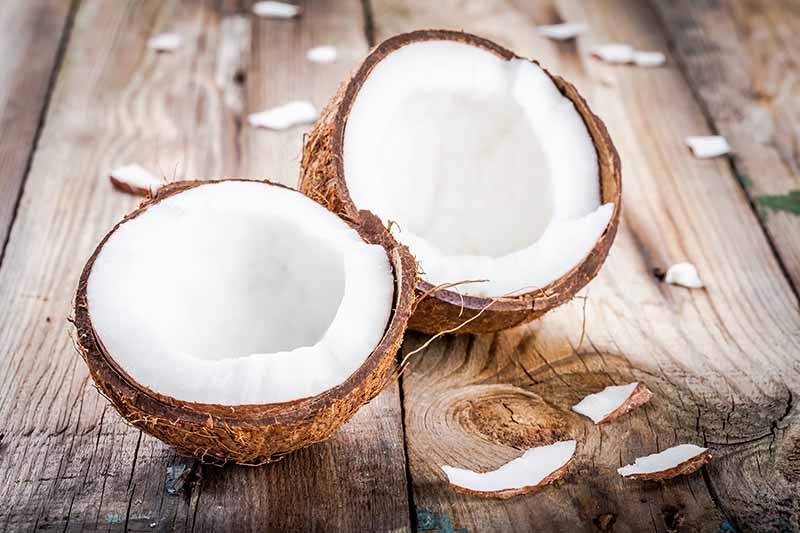
A fully mature coconut takes about a year to grow. At around five to seven months old, an immature fruit contains an abundance of sweet water (we’ll briefly cover this other popular beverage in a moment!) and a soft, gelatinous meat.
When fully mature in about 11 to 12 months, the liquid content reduces, and the meat develops into a firm and white mass.
A mature fruit can weigh anywhere between two and five pounds and contains about 35% husk, 12% shell, 28% meat, and 25% freestanding water.
At this stage of full maturity, the meat’s composition is roughly 45% water, 35% fat, 10% carbohydrates, and 5% protein, according to Harold McGee in his book “On Food and Cooking.”
For more thorough information on coconuts, as well as an obsessive wealth of knowledge on other food items, consider buying McGee’s book, available on Amazon.
One Fruit, Many Applications
The coconut palm has been called the “tree of life” or “tree of heaven,” as a provider of food as well as so many other useful products. The tree and its fruit have been and continue to be a vital component in not only cuisine, but in everyday living.
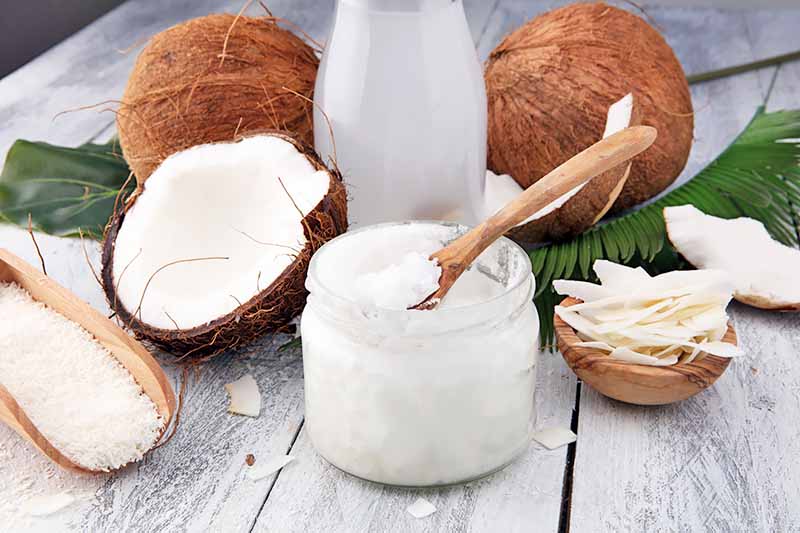
Originating in tropical parts of Asia, the coconut’s critical role as an easily transportable source of food and water, as well as fuel and construction materials, made it a fundamental asset as humans traveled and colonized the land and developed trade routes throughout the Pacific and Indo-Atlantic oceanic regions, and eventually into the New World.
Asia is currently the top producer of coconuts, with 90% of the world’s cultivation coming from Indonesia, the Philippines, India, Sri Lanka, and Thailand.
While we know the interior flesh and water provide sustenance for humans and livestock, other parts of the fruit and tree have many practical uses.
The husks have been used for creating ropes and textiles, the shells can be made into utensils or ground for fuel, the leaves of the tree are used for thatching roofs, and the wood from old palms can be crafted into furniture. And there are a multitude of health and beauty products derived from the meat and water.
But I’m hungry… so, let’s focus on the food!
Let’s “Meat” at the Start
Both coconut milk and cream are made from the same main ingredient: the solid and fatty white meat of a mature fruit.
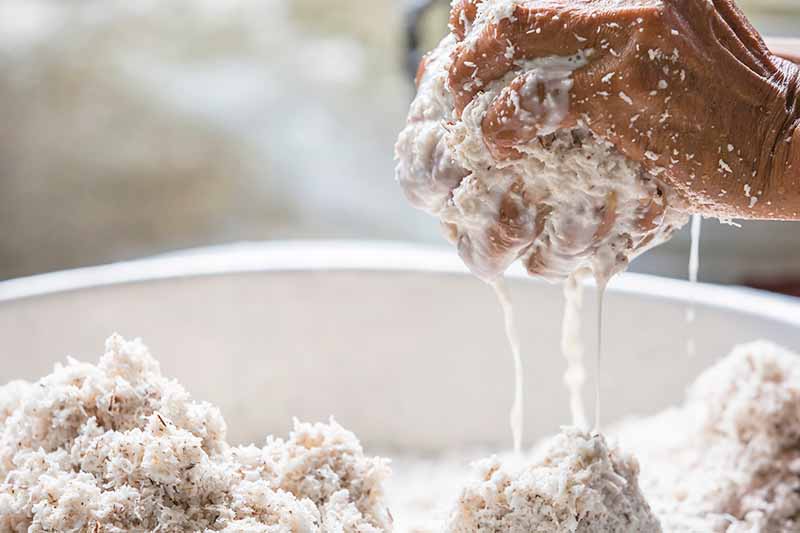
The process to initially extract the milk and cream from the meat is the same for both products.
To obtain the milk and cream, the fresh meat is first removed from the shell, then typically shredded, grated, or pulverized.
The shredded meat can be soaked with or without added water. For maximum extraction, the mixture is typically soaked with heated water to soften the solid pieces.
The shredded meat is then pressed with a weight and strained to remove the solid particles. The resulting liquid is – drumroll, please – fresh coconut milk!
This extraction can be done on a small-scale level at home – you can soak and squeeze by hand the grated fresh meat and then strain that mixture. But large commercial manufacturers use machinery like the screw press to extract everything in greater quantities.
In order to obtain the cream, an additional step must be added to the process of extraction.
Cream of the Crop
So, what is the cream exactly? And how is this different from the milk?
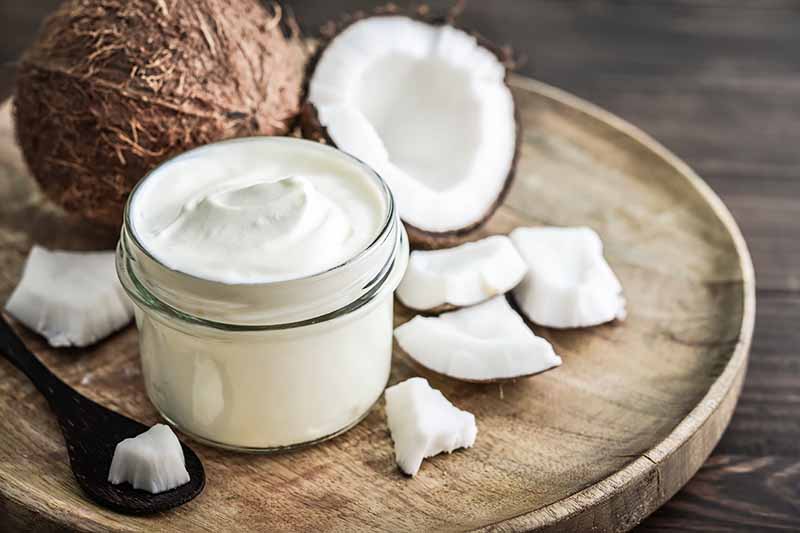
The cream is a more condensed version of coconut milk, with very little liquid and higher amounts of solids in the form of proteins, fats, and carbohydrates.
For a more thorough answer, we can turn to the Standard for Aqueous Coconut Products, a set of guidelines created by the Codex Alimentarius Commission, which was established by the Food and Agriculture Organization (FAO) and the World Health Organization (WHO) as a reputable reference guide for the safety, quality, and fairness of international food trade.
According to these standards, coconut milk is identified as a dilute emulsion. Its composition is between 12.7 to 25.3% total solids, at least 10% fat, and at most 87.3% moisture.
Coconut cream is identified as an emulsion extracted from the meat, with or without any addition of water. Its overall composition is 25.4 to 37.3% total solids, with at least 20% fat, and at most 74.6% moisture.
Based on these factors, the cream has less liquid, more total solids, and more fat than coconut milk.
A common method for producing coconut cream is done via the eponymously named process of creaming. After the milk is strained and allowed to sit for a few hours uninterrupted, natural separation occurs. Most of the fat and some other solids separate and rise to the surface of an unhomogenized liquid due to its lower density.
Manufacturers skim this layer off, and use it in retail products.
This isn’t the only method to make it. It can also be produced by soaking a much higher ratio of flesh to water compared to what would be done for producing milk.
While coconut cream and milk can be purchased as two separate retail products, you’ll often see cream in cans of the milk, particularly those that contain lower quantities of stabilizers, or none at all.
When you open a can, you’ll see an obvious separation of two distinct layers: the white, solid, creamy layer on top, and the liquid on the bottom.
This separation can still occur with products sold as coconut cream as well, as it is not completely devoid of liquids in its final composition. You’ll find there won’t be as much liquid in these cans as what you’ll find in the cans of milk.
The layers can easily be reincorporated together with a whisk.
Refined and Stabilized: A Different Life in Cans
Can’t get your hands on a fresh coconut? What a bummer! But it’s not a problem – the milk and cream are readily available at grocery stores in cans.

And it shouldn’t come as a complete shock that these products have gone through a significant level of processing from fresh fruit to sealed container that’s ready for purchase.
For these ingredients to be shelf stable at the store, various processing methods are applied to the products before or after being hermetically sealed in order to preserve the quality and extend the storage life.
Pasteurization, sterilization, and ultra-high temperature treatments are among the most common heat treatment methods.
The thickness and texture of the shelf-stable items are also manipulated to better yield a product that is consistent and standardized across all products of a particular brand.
Because coconut milk and cream are only weakly stabilized or thickened by the proteins and phospholipids naturally present in the liquid, manufacturers can choose to maximize the milk’s thick, creamy, and emulsified texture by incorporating additional ingredients and homogenization treatments to ensure its stability long-term in cans and cartons.
Many cans available for retail sale can contain different food-safe emulsifiers, preservatives, bleaching agents, and stabilizers/thickeners, within a regulated maximum range. Common thickeners include guar gum, xanthan gum, gellan gum, and cellulose.
Each grocery or specialty food store you visit may carry different brands in a range of prices, thickness levels, and styles, made with various ingredients.
As far as our advice goes for what brands you should buy, it’s best to begin by quickly reviewing the nutrition labels.
Choose the option that has the least amount of added ingredients – the less, the better, if you want to find the least manipulated product.
Employ a rule of 3 – there should be no more than 3 total ingredients when buying cans.
Remember that whatever appears first on the label appears in the highest quantity in the product. The first ingredient should always be coconut, followed by water.
Don’t be upset… but for the majority of canned options, you can expect to see a stabilizer on the ingredients list. Guar gum and xanthan gum are the most common ones you’ll find.
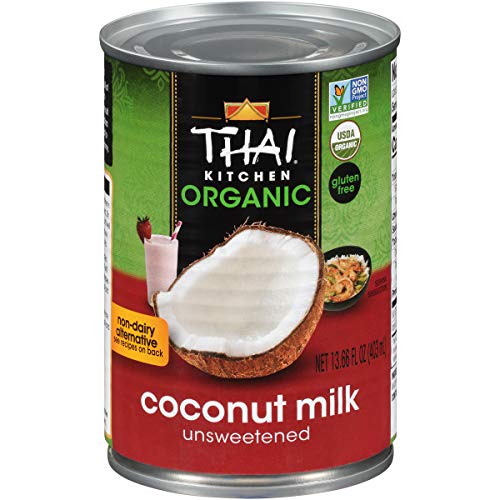
Thai Kitchen Organic Unsweetened Coconut Milk, 6-pack, available on Amazon
Thai Kitchen is a popular brand for higher quality products. Their organic unsweetened coconut milk contains coconut, water, and guar gum. Find it now on Amazon.
The same ingredients are used in their canned coconut cream, as well. It’s also available to purchase on Amazon.
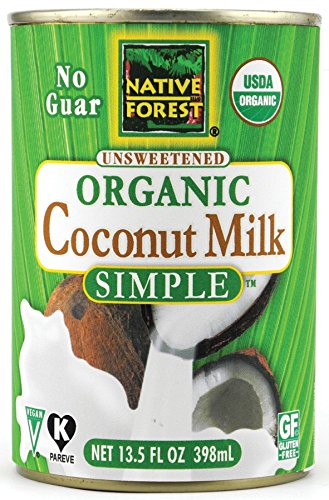
Native Forest Simple Unsweetened Organic Coconut Milk, 6-pack, available on Amazon
If you’re still not on board with the gums, consider buying Native Forest’s Unsweetened Organic Coconut Milk, available on Amazon. This product contains absolutely no stabilizers – the listed ingredients are just organic coconut and filtered water.
The Other Guys
We can’t talk about this subject without a very brief mention of some of the other popular products you’ll often see at the grocery store!
Coconut Water
A common misconception is that coconut milk is the water inside a young or mature fruit, but these are most definitely two very different food items.
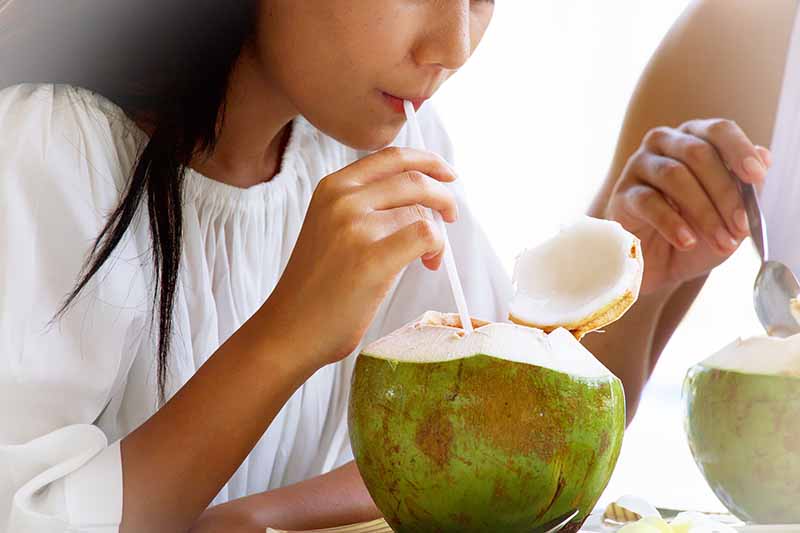
Coconut water is the freestanding liquid that’s found when you break open the fruit, separate from the meat. As explained in the anatomy section above, the water is the liquid endosperm of the seed.
The water is at its sweetest and most prevalent in a young fruit, and it is popularly consumed and enjoyed in its raw form as a refreshing and thirst-quenching beverage – green coconuts and the water inside can be served and enjoyed as is or used as a base for making fun cocktails.
Just like the milk and cream, the water is also a commonly available shelf-stable or refrigerated product in grocery stores, usually sold with the addition of sugar or preservatives.
Coconut Milk Beverage
It is also important to note that, more often than not, cans of coconut milk and cream are entirely different products from what you’ll find in cartons.
Designed to be a daily dairy milk substitute like almond, soy, or oat milk, these beverages are sold in a variety of flavors like vanilla or chocolate, to name a few. They may be sweetened or unsweetened.
These also include a blend of added vitamins and minerals as well as stabilizers/thickeners.
Cream of Coconut
Unless you’re making pina coladas for the group, you should also steer clear of canned or bottled products marketed as cream of coconut. This product is not the same thing as a can of plain, unsweetened cream.
It contains added sugars, in addition to preservatives, stabilizers, and thickeners. The cans of plain milk and cream are typically unsweetened, whereas this product is high in sugar, and more like a syrup.
Coconut Milk Powder
This shelf-stable product is made from dehydrated coconut milk.
Similar to dry cow’s milk powder, it can be reconstituted with a liquid. Use it as an easy dairy-free addition to everything from hot cocoa to smoothies and sauces.
This option is a smart choice to keep in your pantry when you only need to use a little at a time in recipes. Unlike a can or carton of milk that must be refrigerated after opening and used within a limited amount of time, the powder format remains shelf-stable for months once opened.
Depending on the brand, there may be ingredients added to maintain its keeping qualities or to prevent clumping.
For whatever recipe you’re making, just be sure to review the labels when you buy. Products are typically prominently labeled as being sweetened or unsweetened, and you can also check the nutrition facts to see if there are any added sugars.
Calm Down, It’s Not That Bad to Eat!
While the milk and cream are often attacked for their high saturated fat content, these products can be enjoyed without fear when consumed in small quantities and incorporated into a well-balanced diet!
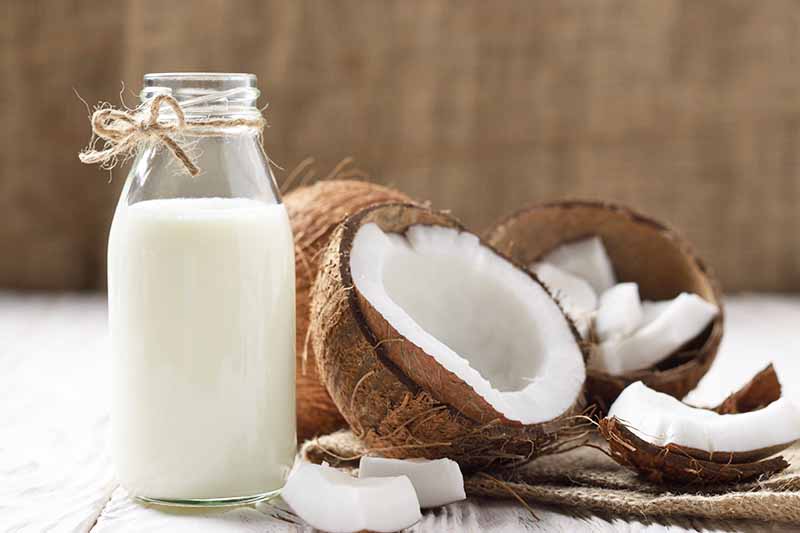
Just, you know, don’t eat spoonful after spoonful in one sitting.
While coconut milk and cream contain small amounts of various vitamins and minerals, they are indeed major sources of dietary saturated fats.
But this isn’t all terrible news! According to a 2020 study, their saturated fats contain phenolic substances that have antioxidant properties which can protect your body’s lipids, proteins, and DNA against oxidative stress and damage.
Because canned coconut cream is a condensed form of the fats and other solids in combination with less liquid, it also contains more calories, and the recommended serving size is significantly smaller than that of the canned milk.
Most canned brands list a recommended serving size of two tablespoons of cream, compared to about 1/3 to 1/2 cup for milk.
As listed in the USDA’S FoodData Central, a 1/2 cup serving of unsweetened canned coconut milk has about 197 calories, and contains 21.3 grams total fat, of which 18.9 grams is saturated fat. It also contains 18 milligrams calcium, 46 milligrams magnesium, 96 milligrams phosphorus, and 220 milligrams potassium.
As for coconut cream, the USDA’S FoodData Central records it as having 67.8 calories per 1 tablespoon serving, with 3.1 grams total fat (2.94 grams of which are saturated), 0.76 milligrams calcium, 3.23 milligrams magnesium, 4.18 milligrams phosphorus, and 19.2 milligrams potassium.
The name of the nutrition game? Enjoy, but enjoy sparingly.
Consume these products within the recommended serving sizes, and you’ll be rewarded with both culinary delights and some small potential health benefits.
And if you’re looking for a substitute for dairy to put in your smoothies and cereal every morning, consider boxed products that are lower in saturated fat per serving, with a boost of added vitamins and minerals like you’ll find in other comparable dairy-free beverages.
You can also choose to buy cans of light/lite coconut milk, which has more liquid and less solids than full-fat canned products. It’s pretty much the opposite of cream!
According to the Standard for Aqueous Coconut Products, canned light or lite milk should have a maximum percentage of 93.4% moisture, and a range of 6.6 to 12.6% total solids. There should be a maximum of only 5% fat.
If using this product, your recipe will certainly lack creaminess and richness, and will definitely be more watery than it would if using other alternatives. However, this can be a useful measure to limit your fat intake.
Uses for Both Products in Recipes
These multipurpose ingredients are both so easy to incorporate into recipes at home!
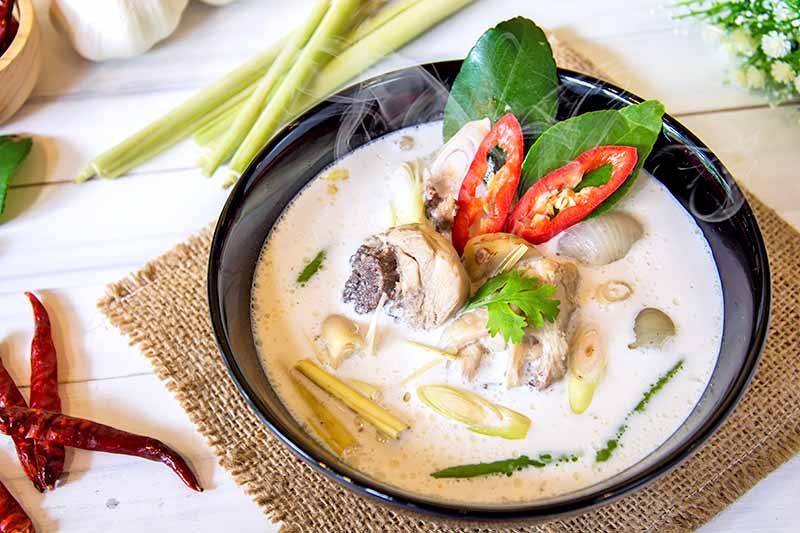
Their versatility is also a huge benefit, as these silky ingredients have seduced their way into both sweet and savory applications.
Beloved among vegans, vegetarians, and those with dairy allergies or intolerances, coconut milk and cream are two useful dairy-free ingredients to keep stocked in the pantry.
As a smart replacement for cow’s milk products in recipes, they are revered for their varying levels of thickness, smoothness, and richness.
With its solid and denser texture, the fatty cream should be used when you’re looking for more overall richness and thickness in a recipe.
It’s a natural for whipping with some powdered sugar and a pinch of salt when you want to serve a non-dairy whipped cream on the side of a vegan pie, cake, or pastry.
The canned milk is an easy choice when you want to gently thicken and add a slyly sensuous mouthfeel to soups, stews, sauces, and purees.
Due to its higher liquid content, it won’t be as condensed in flavor or thick in texture as coconut cream – instead, it will be a more subtle choice for recipes that you are cooking and baking.
Using a boxed coconut milk beverage or one that comes in a refrigerated carton, however, has its limitations. This type of product is incredibly diluted in comparison, and is designed for use as a replacement in recipes and meals where you would typically use dairy milk.
Save this one (and any of its flavored and sweetened brethren) for splashing in your milkshakes, pouring over cereal and granola, adding to warm oatmeal, or drinking on its own.
For more recipes that use the sultry, flowing beauty of coconut milk, feast your eyes on these finds from Foodal:
And if you want to add intense unctuousness to your recipes, consider some of these options from Foodal that use coconut cream:
These are just a few suggestions among the many applications available for the milk and cream across the sweet and savory food landscape.
Keep a can or two on hand at all times in your kitchen cabinet, and you’ll have a fun excuse to start improvising by adding a tablespoon or two here and there when you’re cooking in the kitchen.
Have some leftovers? You can store them in the refrigerator or freezer without a problem. The remaining contents in an open can should be transferred to an airtight container or bag and stored in the refrigerator for up to one week, or in the freezer for up to six months.
When ready to use from the freezer, place the container in the refrigerator for about 8 to 12 hours, or until defrosted completely. Stir the defrosting contents if the liquid has separated.
You Can’t Go Wrong with Either One
In the end, even if you accidentally picked up a can of coconut cream instead of milk, or vice versa, it will be fine.

You can manage this little mistake easily. A small “oopsies” moment keeps us on our toes, and forces us to playfully and confidently adapt while we’re in the kitchen.
Did you grab milk instead of cream for your recipe? Just reduce the amount of other liquid your recipe calls for by about one third. Or, better yet, if you open up the can to reveal natural separation, just skim off the fatty layer from the top and use that! Save the liquid portion for another use.
You can simply add more water to the recipe if you were distracted at the store and picked cream instead of milk. Start with about 1/8 cup, and adjust from there to get your desired consistency.
Though you may want to save the sugary cans or squeeze bottles of cream of coconut for later if you misread the labels when shopping for the ingredients for the curry dinner you were planning to make tonight.
Remember those pina coladas I was talking about? Now’s the time to get out the rum.
Do you have a favorite product among the ones we covered here? How do you like to use these fun dairy-free alternatives in your cooking? I’m still hungry, and in need of new recipe ideas! Comment below when you get a chance!
Looking for other crazy deep dives on some common ingredients and food terminology? Nerd out with more of our informational articles:
© Ask the Experts, LLC. ALL RIGHTS RESERVED. See our TOS for more details. Uncredited photos via Shutterstock.
The staff at Foodal are not medical professionals and this article should not be construed as medical advice. Foodal and Ask the Experts, LLC assume no liability for the use or misuse of the material presented above. Always consult with a medical professional before changing your diet, or using supplements or manufactured or natural medications.
About Nikki Cervone
Nikki Cervone is an ACS Certified Cheese Professional and cheesemonger living in Pittsburgh. Nikki holds an AAS in baking/pastry from Westmoreland County Community College, a BA in Communications from Duquesne University, and an MLA in Gastronomy from Boston University. When she's not nibbling on her favorite cheeses or testing a batch of cupcakes, Nikki enjoys a healthy dose of yoga, wine, hiking, singing in the shower, and chocolate. Lots of chocolate.




